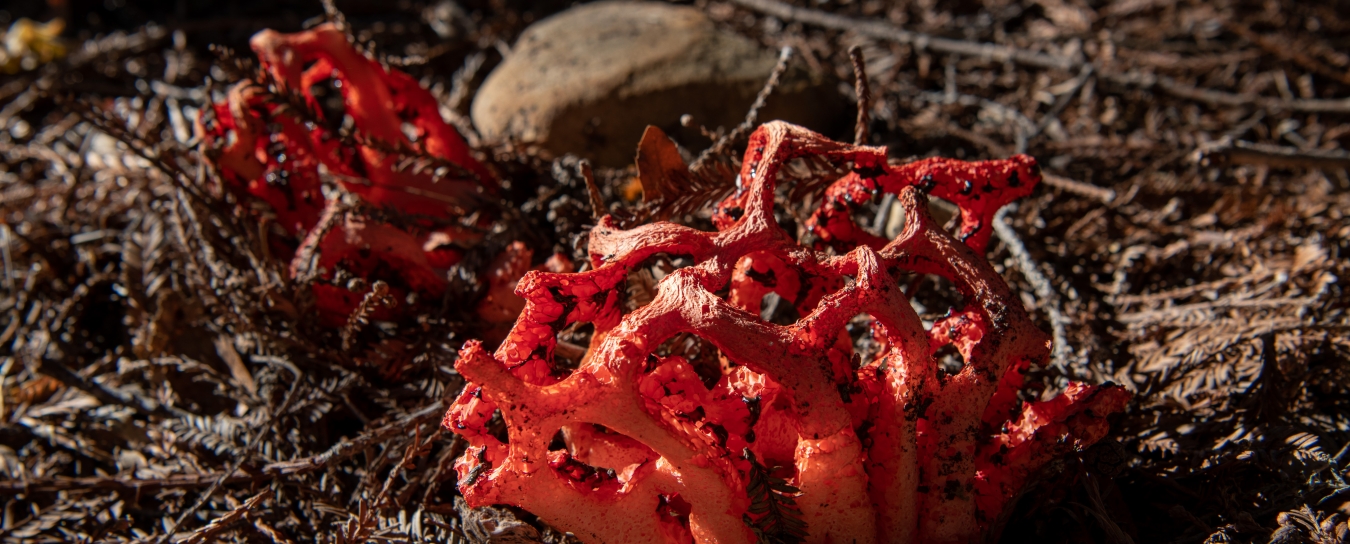
Fungi
Our fungi identifications are courtesy of fungi expert Bob Cummings, who teaches in the Botany Department at Santa Barbara City College in the Biological Sciences. Before you ask, check to see if your fungus has been identified below.
- Anthropology
- Rocks & Fossils
- Invertebrates
- Vertebrates
- Botany
- Astronomy
- Fungi
- General
- Recently Asked
What species is this Stinkhorn mushroom?
These stinkhorn mushrooms are sprouting up recently after a rain all over our trails in suburban Dallas area. They are beautiful. Extremely fragile. And pollinated by ants, flies and even millipedes. Your help is much appreciated.


Curator Response
Hi Richard,
Whenever we have a question that requires a fungi expert, we ask Bob Cummings, who teaches in the Botany Department at Santa Barbara City College in the Biological Sciences. He was able to confirm that this is a kind of stinkhorn he has identified for us before.
Your interesting observations about the arthropods and fungal "pollination" inspired us to ask Bob to more about that, too. Here's his full response:
"Yes, this is Lysurus periphragmoides, the Stalked Lattice Stinkhorn. It has a world-wide distribution in tropical to subtropical areas, so that fits with its appearance in Dallas.
Fungal spore dispersal vs plant pollen dispersal:
Mushrooms, including stinkhorns, reproduce by spores. Most species of fungi disperse their spores by wind. But not all. In the case of stinkhorns, the fruiting bodies produce wet, sticky spore masses. Maturation of spores is accompanied by the production of various volatile molecules that smell like rotting animal tissues. Flies (and other insects, etc.) are attracted to the "stinky" fruiting bodies, pick up the sticky masses of spores on their bodies, then fly away to deposit the spores in other locations. If fungal spores were "pollen," then these insects would be considered "pollinators."
Wait a minute, plant pollen grains are spores!
Each plant pollen grain contains a microscopic male gametophyte that produces sperms once in contact with the ovule, resulting in fertilization and seed production. The earliest land plants dispersed their pollen by wind. The wind pollination method was so successful that many plant groups evolving later, such as conifers, grasses, oaks, etc., continue to use wind for pollination. However, some groups of flowering plants have evolved to take advantage of insects as pollen dispersal vectors. Indeed, insect pollination among flowering plants occurs now in roughly 75% of species. It is interesting for botanists to note that there has been a co-evolution of pollinators and the flowers they pollinate. For example, consider the astounding story of "Darwin's Orchid" and the eventual discovery of its pollinator.
Bottom line: Some groups of fungi, notably the stinkhorns, have experienced their own co-evolution with insects, resulting in the same evolutionary advantage of enhanced spore dispersal. Using flies isn't unique to fungi. Compare it to the pollination mechanism of similarly stinky "carrion flowers" (Stapelia spp, etc.). Do the flies know they are being used?"


